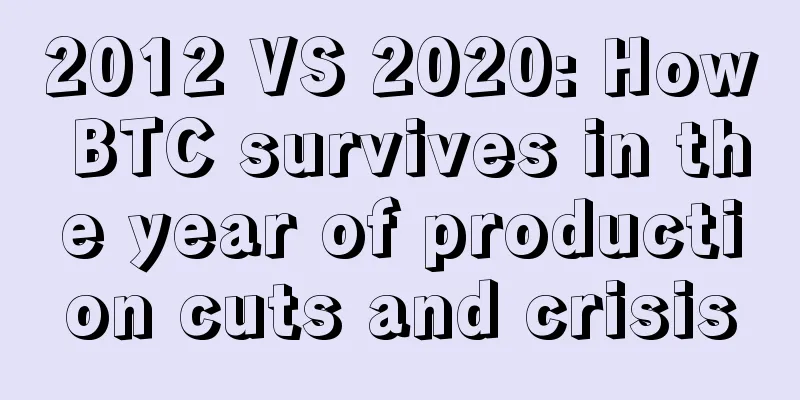2012 VS 2020: How BTC survives in the year of production cuts and crisis

|
Despite the ups and downs of Bitcoin in February and March, Bitcoin has maintained its 21% QTD (quarter-to-date actual balance) increase. However, recent macro events in both traditional and crypto markets have increased uncertainty, making the performance of the crypto market full of variables. However, when we look back, investors will find that the current market conditions are somewhat similar to those in 2012. Both 2012 and 2020 were the years of Bitcoin halving, and both faced economic crises. Looking back at 2012, can history reveal more details before and after the halving from a macro perspective? This is what we expect, especially in light of the global crisis and stock market turmoil this year. Pandemic-driven sell-off February was a tough month for the cryptocurrency market. As concerns over the coronavirus outbreak escalated, BTC prices plummeted from the $10,400 level in the middle of the month to close the month in the $8,500 region. As the epidemic spread around the world, the price of Bitcoin accelerated its decline to below $4,800 in mid-March. Bitcoin price trend so far this year. Source: Feixiaohao Risk aversion was also high in global stock markets. The Dow Jones Industrial Average fell 1,190 points before its first rebound on February 27, the worst single-day drop in history. The U.S. stock market was circuit-breakered four times in 10 days, and the New York Stock Exchange urgently closed its trading floor for the first time in 227 years. Commodities were also hit hard, with U.S. West Texas Intermediate crude oil (WTI) falling below $50 per barrel. On the other hand, safe-haven demand surged as the 10-year U.S. Treasury bond hit a record low of 1.03% before stabilizing around 1.08%. Year-to-date cross-asset performance. Source: Tradingview Meanwhile, the broader market reaction seems to be a bleak picture, and the cryptocurrency market is not immune. Some people question the safe-haven function of Bitcoin because it does not seem to be able to hedge against the current market uncertainty. 2012 VS 2020 Despite the recent global market turmoil, the upcoming Bitcoin halving remains the focus of most crypto observers. Perhaps we can look back to 2012, when the first Bitcoin production halving took place, and at the same time, the market was in another turmoil - the European debt crisis. The European debt crisis began in 2009. Without the help of the European Central Bank (ECB) or the International Monetary Fund (IMF), some EU member states were unable to refinance their government debts, and some countries were unable to rescue heavily indebted financial institutions. The markets in 2012 and 2020 share similar backgrounds Of course, the overall stock market and cryptocurrency space in 2012 was very different from where we are today. However, the risk aversion, pessimistic outlook, and fears of a recession are very comparable. Interestingly, Bitcoin rose by about 160% in 2012 amid the Eurozone debt crisis, with most of the gains occurring before the first drop. Profits were even more pronounced in the year following the halving. In comparison, the S&P 500 rose by 14.5% and the Euro Stoxx 50 rose by about 11.2% in 2012. Bitcoin and traditional economy We continue to emphasize the value attributes of Bitcoin and believe that Bitcoin is an ideal hedge against inflation due to its limited supply. In other words, Bitcoin can be a good hedge against the depreciation of fiat currencies. Back in the early 2000s, the European debt crisis focused on structural problems in the financial system and loose credit conditions, resulting in large-scale bailouts and interest rate cuts. These measures led to a sharp depreciation of the euro. At the end of 2011, the euro-dollar exchange rate was above 1.4. By mid-2012, the euro/dollar had fallen to 1.20, and then rebounded to 1.3. Debt crises have led to some major currency devaluations, and Bitcoin responded to that devaluation in 2012, even before the first halving event. Now, given the ongoing uncertainty related to the coronavirus, market conditions are fundamentally different from the debt crisis. However, what the market is experiencing is somewhat similar to what we experienced in 2012. We should pay more attention to how policymakers respond to the epidemic and the resulting economic consequences, and how the capital markets react. As an emergency measure, the Federal Reserve issued a half-percentage-point rate cut. The U.S. dollar index has fallen from a high of 99 to a low of 97. The market expects the Fed to cut interest rates further at its March policy meeting. At the same time, easing policies from other major central banks have also emerged rapidly. These shifts may put pressure on G10FX, which may be another favorable factor for Bitcoin prices in the medium and long term. Be patient and watch the BTC halving The price increase after Bitcoin halving tends to be extended each time, and this market cycle is not expected to be completed until 2022. Although the recent price trend does not look optimistic, the market is still in an ideal period of rise. Long-term investors may need to be more patient to see the results. In conclusion: The Bitcoin market was still small when the European debt crisis hit, and it remains relatively small today compared to other major asset classes. Bitcoin and cryptocurrencies may not be the best hedge against a global recession, as Bitcoin hoarders may liquidate their holdings to cover their losses in other assets or to pay off debts. However, when a crisis strikes and policymakers are inclined to adopt an accommodative approach, Bitcoin may be an ideal tool to protect against currency debasement. In this pre-halving period, the development of the global market is of vital importance to all crypto investors, and how economic policies will develop in the future may be the main factor affecting investors' allocation of crypto assets. |
<<: How does 5G unleash the potential of blockchain?
Recommend
Women with moles above the corners of their mouths are naturally beautiful
Women with moles above the corners of their mouth...
Analyst: There is no sign of easing in the sell-off, Bitcoin forms a "death cross", and the subsequent trend is unclear
The news that the People's Bank of China has ...
BCC, which was born on August 1, is not a fork of the Bitcoin network
Bitcoin has successfully activated the SW2X ( Seg...
Analysis of facial features of people with moles on their ears
Everyone has some moles of different sizes on the...
Is it good for a woman with a mole on her lower lip to have a good life? Is it good for a woman to have a mole on her lower lip?
Although moles seem to grow randomly, they actual...
What kind of women have artistic talent?
In ancient times, women were considered virtuous ...
Federal agent sentenced to 6 years in prison for embezzling Silk Road Bitcoin
NetEase Technology News, December 9, according to...
How to read palmistry
Palmistry has been popular in my country for thou...
Blockchain 3.0 (Part 4): Digital Identity Verification
In the previous article, we mentioned the decentr...
List of closed exchanges and mining pools, continuously updated
Exchanges name Last shutdown time Huobi Coin-to-c...
Moles on eyebrows: fortune telling with pictures
Moles on eyebrows: fortune telling with pictures ...
The mining industry is growing exponentially, and mining machine manufacturers may become the biggest beneficiaries
In April, Bitcoin saw six consecutive positive mo...
What does a person who loves to spend money look like?
Every girl loves beauty, but it is best to contro...
Hyperledger adds new members, two blockchain technology companies from Hangzhou join
On September 26, Hyperledger announced the list o...
What is a beauty peak?
In the Tang Dynasty, fat was considered beautiful...









